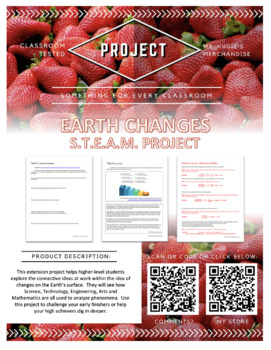Earth Changes | S.T.E.A.M. Project
- PDF
- Internet Activities
Also included in
- Elementary S.T.E.A.M. Extensions BundleAppropriate for grades 3-7 & HomeschoolPURPOSE:These three transdisciplinary extension projects are the perfect addition to your regular math class curriculum! They were originally designed for higher-level and early-finishing students in mathematics! ThisPrice $24.99Original Price $29.97Save $4.98
Description
Earth Changes S.T.E.A.M. Project
Appropriate for grades 5-7 & Homeschool
**Also found in THIS bundle**
PURPOSE:
This extension project helps higher-level students explore the connective ideas at work within the idea of changes on the Earth’s surface. They will see how Science, Technology, Engineering, Arts and Mathematics are all used to analyze phenomena. Use this project to challenge your early finishers or help your high achievers dig in deeper.
WHAT’S INCLUDED:
This product contains:
☆6 specific S.T.E.A.M.-based tasks for deeper exploration of the how and why of human movement across the earth
☆2 tasks dedicated to a hands-on building challenge
☆A final building challenge requiring students to meet criteria and solve a problem
☆Planning pages and reflection page for that final building challenge
☆3 pages of hints and answer keys for various tasks
☆A rubric for grading the complete assignment
STORY:
Last school year, I was given the opportunity to become math coordinator for my school. In asking the teachers what they needed most for their classrooms, they spoke of high quality extension work for the advanced students or early finishers. So I set out to make an integrated S.T.E.A.M. project for each of the upper elementary grades: 3rd, 4th and 5th. The final product was implemented into 6 classrooms in each grade level and was well received by students and teachers. The copy you could download today is that same project.
POSSIBLE EXTENSIONS:
Possible extensions are included in the file!
MATERIALS/PRE-REQS:
Besides this file, you may require:
☆Craft or building materials (cardboard, paper, pipecleaner, etc.)
☆Computer and internet access
*********************************************************************
RELATED PROJECTS from Mr. Kugie’s Merchandise
Other Projects:
☆Texas Railroads S.T.E.A.M. Project
☆Human Movement S.T.E.A.M. Project
*********************************************************************






